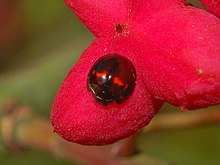Chilocorus bipustulatus
| Chilocorus bipustulatus | |
|---|---|

| |
| Scientific classification | |
| Kingdom: | |
| Phylum: | |
| Class: | |
| Order: | |
| Family: | |
| Genus: | |
| Species: | C. bipustulatus
|
| Binomial name | |
| Chilocorus bipustulatus | |
| Synonyms | |
| |
Chilocorus bipustulatus, the heather ladybird,[1] is a beetle species belonging to the family Coccinellidae, subfamily Chilocorinae.[1]
These beetles are found in most of Europe, in East Palearctic ecozone, in the Near East and in North Africa. [2]
The elytra of this small beetle have a shining brown colour with two reddish-orange spots on each elytron (hence the Latin word bipustulatus, meaning two-blistered). Sometime three spots run in an horizontal line and join into two larger stains.
The mature larva is about 5 millimetres (0.20 in) long. Wintering occurs as an adult. The adults grow up to 3–5 millimetres (0.12–0.20 in) long and can be encountered from May through October.
Heather ladybirds feed on aphids and scale insects, small insects mainly belonging to the family Coccidae and Diaspididae (Saissetia oleae, Aspidiotus nerii, Chionaspis salicis, Chrysomphalus aonidum, Pseudaulacaspis pentagona, Planococcus citri, etc.). Therefore this species has been introduced worldwide for biological control in case of infestations.[3][4]
References
- ^ a b c Biolib
- ^ Fauna Europaea
- ^ Commercially used biological control agents
- ^ Mansour, Rramzi; Mkaouar, Rim; Lebdi, Kaouthar Grissa; Suma, Pompeo and Russo, Agatino (2011). "A survey of scale insects (Hemiptera: Coccoidea) occurring on olives in Tunisia". Journal of Entomological and Acarological Research. 43 (3): 315–322.
{{cite journal}}: CS1 maint: multiple names: authors list (link)
